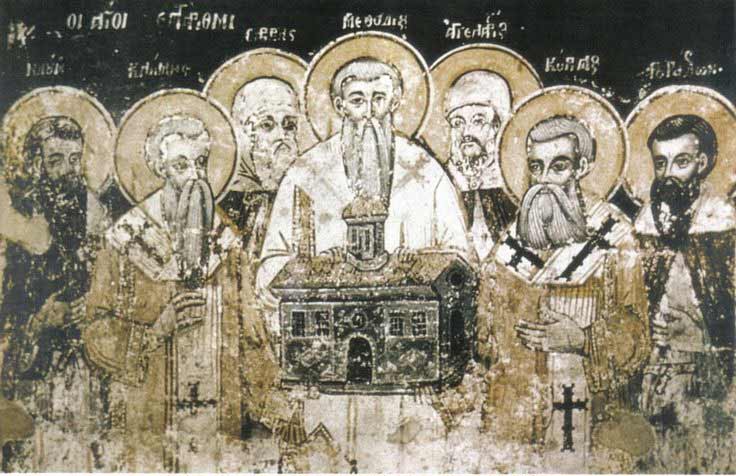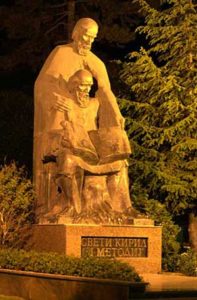TRADITION
The meeting of the two different worlds, the Romaic and the Slavonic one, at times manifested through actual contacts, at others through a symbiotic link existing between them, is a key factor in an interpretation of international relations in Eastern Europe in the Middle Ages. The communication, initiated with violence on both sides, in the Balkans, on the northern coast of the Black Sea and in Russia, where the newcomers had already established themselves, was gradually transformed into a search for common interests in establishing links. In the creative field an acculturalization, to use the language of socio-anthropologists, occurred. The differing cultures met one another and yet retained their characteristic features. Their common denominator was Christianity. There developed a complex and not clearly defined process, impelled by a peculiar tension, and not yet thoroughly elucidated, known as the Slavonic-Byzantine cultural realm. Two factors were of great significance in its creation: the Mt. Athos monasteries and the tradition of Cyril and Methodius. An environment which was to serve as a mediator and a catalyst in the establishment of a common Slavonic and Byzantine civilization was created as early as the 10th century on the easternmost of the three extremities of the Peninsula of Chalcidice in the Aegean Sea, in the monastic republic of Mt. Athos, and as early as the 9th century in the homeland of the Macedonian Slavs.
The tradition of Cyril and Methodius, as the most common syntagma in Slavistics, most accurately describes the significance of the Slavs in the Middle Ages. Firstly, this syntagma refers to all materials translated into or originally written in Old Church Slavonic and, secondly, it describes a characteristic attitude towards the world, partly religious, partly political and reflected also in the sphere of culture which determined the specific and widespread domain of the Slavs in the Christian world.
ROOTS
“Preaching without an alphabet and books is like writing upon the water,” said Constantine, whom the sources also call Teacher and Philosopher, to the Byzantine Emperor Michael III prior to departing for Greater Moravia, the first, however short-lived, Slavic state, established on the territory of the present-day Czech and Slovak Republics. This happened in 863.
The emperor was fully aware to whom he assigned the mission of an apostle among the Moravian Slavs who had already been converted to Christianity by German missionaries. When the historic appeal of Prince Rastislaus, who was trapped between the alliance of the Frankish state in the west and the Bulgarian in the south-east, reached the Byzantine Empire, Michael did not hesitate in his choice of people who would preach the gospel in Slavonic in Moravia. Constantine, who taught and instructed at the court in the Imperial City, in the Great Magnaura School, a centre of mediaeval scholarship and education, was the younger brother of Methodius, who, certainly with the approval of Constantinople, governed in the Slavic princedom in Macedonia. Scholarship has yet to offer a precise answer regarding the location of this princedom. The majority of scholars believe that it was situated in the Bregalnica region. This supposition is supported by the eventuality that Cyril and Methodius conducted their first conversion of Slavs among the people inhabiting this river basin. Archaeological investigations, however, have still not been exhaustive.
The two brothers, already experienced in missionary work or, to use the language of modern times, diplomacy, through their missions with the Saracens and Khazars, alone represent the inception of the Slavonic-Byzantine conjunction. Their birthplace, Thessaloniki, the most significant Byzantine centre after the metropolis itself, experienced a considerable boom after the great and ancient cities of Antioch and Alexandria fell under infidel rule. There, on the furthermost edges of the empire, the inhabitants were bilingual. In the language of the Romaics there was a specific term, the word Akritas, denoting a “citizen of a frontier country”.
The fifth chapter of Constantine’s Life states: “everybody in Thessaloniki speaks Slavonic”. The same text reduces the Moravian mission of Constantine and Methodius to fourteen months, between the spring of 864 and the end of the summer of 867. The manuscript also speaks of their work on the territory of present-day Hungary, and the hospitality of Prince Kocel in Pannonia, where they rested on their journey to Rome. To the Holy seat and the Pope Hadrian the Second, the brothers brought the remains of Clement, the holy Roman pope and a successor to the apostle Peter. The sources claim that it was in Crimea, among the Khazars, that the educators and enlighteners found and recognized Clement’s remains. In Rome, Constantine took his monastic vows, the black habit and his spiritual name, Cyril. He also died there, at 42 years of age, on l4th February 869; he was laid to rest by the altar of the Church of San Clemente. This explains the origin of the two depictions of the Brothers in the frescoes in this Roman basilica, one by the northern entrance from the end of the 9th century and the other in the narthex from the end of the 11th century. Both of them are subordinate to the celebration of St. Clement, the patron.
When did the tradition start?

A Fresco portraying Saints Cyrilus and Methodius standing before Christ and two angels, 11th century, the crypt of Saint Clement’s church Rome, Italy.
The missionary enterprise to Moravia was neither exceptional nor was it unique. It was but a part of the long course of history. For the Slavs it was fundamental, for the Byzantine Empire it was an appropriation of the largest sphere of interest. It took place during the renowned times of the three designers of the fundamentals of Byzantine politics, the patriarch Photius, the emperor Michael III and his uncle, the Bardas Caesar, when the veneration of icons was introduced and with this the foundations of Orthodox Christianity were laid.
Their diplomatic and military leadership was part of the historic interest of the great empire in both secular and religious supremacy over the world. The “transplantation” of Christianity to new ethnic territories proved to be the most appropriate means of achieving this goal. At the same time, the enlightened regent, Bardas Caesar, summoned the most eminent of his subjects to the recently-established Great School in the Magnaura Palace. The school is said to have been headed by the most comprehensive mind of those days, Leo the Mathematician. Spiritual and cultural imperialism with, at one and the same time, a military imperialism spiced with an “elastic” diplomacy was the global political recipe of the governing elite of the Empire. The efficiency of this recipe proved itself in the dispute with Russia (860) and in relations with the old Bulgarian state. By being converted virtually overnight and adopting the name Michael, after the Byzantine Emperor, in 865 Prince Boris unexpectedly betrayed Rome and accepted Byzantine Christianity as his state’s official religion. This is how Macedonia, as part of the old Bulgarian state, became part of the Byzantine religious and cultural domain.
What did the tradition emerge from?
It emerged from the script, the Glagolitic alphabet. This was designed by Cyril the Philosopher with, of course, the participation of his brother Methodius. The text “Of Letters” (O pismeneh), most probably composed by one of their disciples, who signed himself as Crnorizec Hrabar (the Brave Monk), testifies to the fact that Cyril devised the first Slavonic alphabet of thirty-eight letters. The letters had both a spoken and numerical value just like the prototype which the Educator and Enlightener used, i.e. the Greek minuscule or cursive. The source for the letters for the characteristic Slavonic sounds lay, by all accounts, in the Coptic and ancient Hebrew alphabets. This new alphabet was named after the Old Church Slavonic glagolati (to speak).
It was obviously considered in the Byzantine Empire that the entire Slavonic world spoke the same language. This was not far from the truth. The genealogical tree of the Slavonic languages – Common Slavonic (Slave Commun) had not yet branched off. In the literary and epigraphic documents in Old Church Slavonic this development, which resulted in a new quality in the language. was not registered until after the year 1100.
What happened in the meantime?
In the meantime, at the beginning of the 10th century, Old Slavonic was expanding rapidly and became the standard language of the liturgy for all the Slavs who had accepted conversion to Byzantine Christianity. Thus as Latin was the “mother-tongue” of all the Romance languages, so was the Common Slavonic language the “mother-tongue” of the languages of the Slavs. The Old Slavonic language, which had the privilege of being the first one to be recorded, enjoys the rights of the first-born. It is the oldest form of a written Slavonic language. This same form of expression and reasoning represented a permanent factor for cohesion, and thus preserved the relatedness between the various Slavic communities, despite the counter-currents in the rapids of history. The Old Slavonic language is the civilizational common denominator of the Slavs. This constitutes the magnitude of the Pan-Slavonic work of the Brothers from Thessaloniki. Based on their native tongue the old literary Slavonic language is, primarily, Old Macedonian. And the entire Slavic world celebrates their name on 11th May, according to the old church calendar. The western world for its part, considering them to be prime-movers of mankind, in accordance with Pope John Paul’s decree of 1981, reveres them as “protectors of Europe”, thus giving them equal status with that of Benedict, the most renowned of the western saints.
What preceded?
In the time of the iconoclasts, the Lombards took Ravenna (751). Rome accused Constantinople. With this, the dispute between the Emperor, Leo III, and the Pope, Gregory II, regarding the christological “icons – yes or no?”, took on even greater political dimensions. Rome turned its back on the Byzantine Empire.
The epilogue is well-known: the enraged curia enthroned Charlemagne (800); the Patriarchate took over Illyricum -the central part of the Balkans – as far as Thessaloniki from the Popes. The Byzantine Empire established a new military and administrative unit: the theme of Macedonia (789-802). Situated in western Thrace with Edirne (Hadrianopolis) for its centre, the new Byzantine Macedonia reflected nothing but impotence; the old one remained in the hands of the Slavs. Thus it does not come as any surprise that the Slavs were one of the Empire’s greatest concerns. In the 7th century, immediately after their arrival, they shattered the imperial rule, from the Danube to the southernmost parts of Greece. The sources indicate that the Balkans became a series of sclavinii: Slavic territories with no organized state, which only formally recognized the supreme rule of the Empire. For the Empire, on the other hand, the peninsula was lost – but only temporarily. It was the Slavs themselves and the social upheaval of the middle ages that forced the Byzantine Empire to find a modus vivendi, a mode of regeneration. The new administrative system introduced in the provinces, called thematic, after its units, the themes, miraculously brought the state back to life and the missionary enterprises of the 9th century, entirely regenerated it.
The inverse chronology proves the same: the circularity of history. Going back to even earlier periods, and studying the archaeological and literary evidence, the conversion to Christianity of the Macedonian Slavs re-occurred – this time as a Byzantine baptism of their territories,
Archaeological research points to an uninterrupted life in Christian Antiquity, especially in the Episcopal centre in the Bregalnica basin – the centre of Christianity in eastern Illyricum. Close by, in the same region, the finds from the region of Vinica offer information on a significant period of Early Christianity: the famous terracotta relief panels from the Kale site are a rare and fertile artistic document concerning the theological messages at the transition from the 5th to the 6th century.
Going further back to the 3rd and 4th centuries we discover that in Diocletian’s time, persecuted and tormented, the Bishop of Antioch, St. Erasmus, reached Ohrid via Lebanon. There, he converted thousands of people and was cast into the dungeons once again. Following this he went to Formia, in Italy, via Dynachium, and died there in the year 303, at a ripe old age. The points from which his cult originated are the very sites of his evangelizing activity – Ohrid and Campania. On a stony cliff near the shore of the White Lake, pre-Christian Ohrid dedicated a cave church to him. The monumental, Early-Christian basilica nearby is justly considered an even older reflection of his fame. The entire western Christian world celebrates the holy powers of St. Erasmus of Lychnidos (Ohrid) in the service of the Passio Santi Herasimi episcopi et martiri.
Shortly after Erasmus’ time, in the 4th century, four persecuted Christians from Asia Minor, among them Theodore, one of the 318 Nicaean fathers, came to Strumica (Tiberiopolis) via Thessaloniki. There they were joined by other evangelizing preachers so that they formed a group of fifteen. This is also where they lost their lives. The text which was composed by the Ohrid scholar and Archbishop, Theophilact (11th-12th c.) to honour their martyrdom, speaks of two churches built in their honour. The older one contained their tomb and they were depicted on its east side (9th-10th c.); the exact location of the other church has not yet been determined.
Any additional confirmation is unnecessary: Macedonia was a devout Christian stronghold as early as the 3rd and 4th centuries. A second Christianization, the Byzantine one, took place in the 9th century. In the interim, with the Slavs and the first Bulgarians, these territories went astray, back to paganism.
What followed?
After the death of his brother, Methodius came back among the Slavs at the behest of Pope Hadrian II. Greater Moravia, however, could not persist on its original road: the German pressure was too fierce for it. Burdened by intrigues, the new Moravian prince. Svetopolk, was openly restrained.
Methodius, for his part, found it hard to cope with being a suspicious personage. Had he not started off as a Byzantine emissary? Had not the Pope himself renounced him? Methodius found consolation in a key scholarly activity – translation. He continued where his brother had left off. No autographs have been preserved but the historical accounts say that the brothers were incessantly engaged in translation. Apart from the Holy Scriptures, the Physiologos (a description of nature), and various liturgical and patristic books, they also translated the fundamental document of Byzantine law – the Nomocanon. Methodius worked tirelessly until he died. On 6th April 885, his disciples celebrated a requiem mass for their beloved master in Latin, Classical Greek and Slavonic around his catafalque. Afterwards, the German clergy entered into a merciless conflict with the followers of the brothers from Thessaloniki.
The Holy seat returned to its conservative mythologizing of the sacred languages of the Crucifixion: Hebrew, Classical Greek and Latin. The first of these three was not of sufficient power to support the idea of Pax Christiana; the second, Rome considered to be no more than a lingua franca the purity of which had been irretrievably lost. Thus for the Popes it was: Lingua sacra lingua Latina est. They believed other tongues to be linguae rusticae, which would defile the Word of God. Such an attitude towards the language was the primary source of Rome’s conservatism, but was of great advantage to the Eastern Christian Empire.
The Moravian mission was, formally speaking, a failure. It would have been a meaningless episode had it not led to the creation of a Slavonic alphabet and the translation of the Holy Books. As it is, the consequences of the work of Cyril and Methodius are of historic significance. A new era had begun. The waters of tradition had begun to flow.

Virtual Macedonia
Republic of Macedonia Home Page
Here at Virtual Macedonia, we love everything about our country, Republic of Macedonia. We focus on topics relating to travel to Macedonia, Macedonian history, Macedonian Language, Macedonian Culture. Our goal is to help people learn more about the "Jewel of the Balkans- Macedonia" - See more at our About Us page.
Leave a comment || Signup for email || Facebook |
History || Culture || Travel || Politics
















